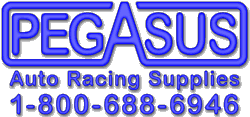| Choosing the right engine oil cooler for a given application can seem like an overwhelming task. Setrab Oil Coolers come in so many shapes and sizes, it's hard to know where to begin. Even their application chart gives you multiple different choices for most engines. A few general tips will help you to narrow down the available options and choose the best one for your specific installation. |
Before We Begin
For the purposes of this article, we will focus on plate-type oil-to-air coolers, such as the Setrab Pro Line. Finned-tube coolers and oil-to-water heat exchangers operate just a little differently. Since we don't offer either of those types, we're going to take the liberty of ignoring them.
Also, in order to avoid apples-to-oranges comparisons, please remember that all assertions imply "all other variables being equal." AGREED, you can change another part of the equation to get the answer you want. Like a track test or dyno run, changing just one factor at a time makes the effect of that change much clearer.
Start with the Chart
Setrab USA has gone to the trouble of providing us with a very handy oil cooler application chart (PDF format) that gives us a starting point without having to do math. The chart covers engine oil coolers, transmission coolers, and even power steering and valve spring coolers. Note that the chart is arranged by part number, not by application. Browse the chart a bit and you'll see that most applications are listed under more than one cooler size.
Oil Flow Restriction and Cooling Performance: Rules of Thumb
Here are some broad, oversimplified, very general principles to keep in mind when choosing a cooler. Remember that all of these imply "all other variables being equal."
- Oil coolers introduce a flow restriction. Our goal is to minimize this restriction.
- There is a direct relationship between plate length and restriction.
Longer plates (rows) = more restriction.
Shorter plates (rows) = less restriction. - There is a direct relationship between plate length and cooling effect.
Longer plates (rows) = more cooling.
Shorter plates (rows) = less cooling. - There is an inverse relationship between the number of plates and restriction.
More plates (rows) = less restriction.
Fewer plates (rows) = more restriction. - There is a direct relationship between the number of plates and cooling effect.
More plates (rows) = more cooling.
Fewer plates (rows) = less cooling. - Two coolers with similar cooling area will have similar cooling performance.
In the list above, the only apparent conflict we have to wrestle with is in plate length. Longer plates cool better (good), but at the expense of flow (bad). Fortunately, the last point in the list above suggests a good workaround: We can choose a shorter cooler to regain some of the lost flow, and simply add more rows to regain some of the lost cooling. Even better, adding more rows simultaneously improves flow even further.
Let's take an example from the Setrab application chart and do just a little math. Say we have a high-performance engine putting out about 325 HP. The chart suggests at least three possibilities: Series 9 with 20 rows, Series 6 with 25 rows, or Series 1 with 50 rows. All three of these coolers have an effective cooling area right around 75 square inches, so their cooling performance is similar.
But the Series 9 will have the most flow restriction (longest rows x fewest rows), and the Series 1 will have the least restriction (shortest rows x most rows). As it turns out, the 25-row Series 6 will have about half the pressure drop of the 20-row Series 9, and the 50-row Series 1 will have roughly 1/10th the pressure drop of the Series 9!
Using real numbers, with a 10 GPM flow rate as an example (not uncommon for an engine running 6000 - 8000 RPM), the 20-row Series 9 will introduce a 5 psi pressure drop from inlet to outlet. (Note that a single 90 degree fitting in your oil line could cause more restriction than that.) The 25-row Series 6 will cause a 2.6 psi drop. The Series 1 will show less than a 1 psi pressure drop. The flow restriction from the Series 1 option may not even register on your oil pressure gauge.
Installation Factors
There are just two general rules when it comes to mounting the cooler. (Remember, "all other variables being equal.")
- Oil coolers require airflow to take heat away. More airflow is better.
- Cooling depends on the difference in temperature between the air and the oil. Cooler air cools better than warmer air.
The airflow equation is a little complicated. As airflow velocity increases, the additional benefit decreases (the graph begins to flatten around 40 mph). The important takeaway is that your oil cooler needs to be exposed to airflow. The largest oil cooler will be ineffective if it's sealed in the trunk or mounted flat up against the firewall. Air must be able to get into the cooler, and it must be able to get out of the cooler. This is what carries away the heat.
In many cars, this suggests mounting the cooler near the radiator. After all, Detroit / Stuttgart / Tokyo spent a lot of time and effort to locate the water radiator where it would get the best airflow. It seems like a no-brainer to follow their lead. But that leads to the second point above.
Air temperature has a direct effect on oil cooler efficiency. Hot air does not cool as well as cool air. This is why we turn on the AC when we're hot, and not the heater. Mounting the oil cooler behind the radiator can reduce the efficiency of the cooler by as much as half. A better solution would be to mount the cooler in front of the radiator. The trade-off is that the efficiency of the radiator will be affected by the air coming through the cooler, but the effect should be much smaller because the cooler is typically smaller than the radiator. An even better option would be to mount the cooler next to the radiator (assuming there is room) or below the radiator (if it can be protected from damage).
The air temperature difference also means that if we run two oil coolers, they should be plumbed in parallel, rather than in series. If you run two coolers in series, the oil in the second cooler would be cooler (closer to the air temperature) than the oil in the first cooler, making it much less efficient. Another bonus to plumbing in parallel is that it has the same effect as adding more rows to the cooler: Less flow restriction for an even happier oil system.
Much more information about mounting oil coolers for maximum air flow with minimum drag can be found in Chapter Nine of Tune To Win by Carroll Smith.
Final Tips
- Always mount the cooler so that it is fully supported, but isolated from vibration and chassis flex.
- Whenever possible, plumb the cooler into the low-pressure (scavenge or return-to-tank) part of the system.
- If the cooler must be pressurized (as in a wet sump oiling system), locate the cooler after the filter.
- Mount the cooler with the outlet fitting (or both fittings on a Pro Line cooler) at the top to avoid air pockets.
- If your cooler is too efficient, tape or block off part of it to bring oil temperatures back up to the desired temperature.
Buy Setrab Oil Coolers:
Setrab Oil Coolers
Setrab Series 9 (Wide) Pro Line Coolers
Setrab Series 6 (Medium) Pro Line Coolers
Setrab Series 1 (Narrow) Pro Line Coolers
More Technical Information:
This article was first published on 10/5/2016.


